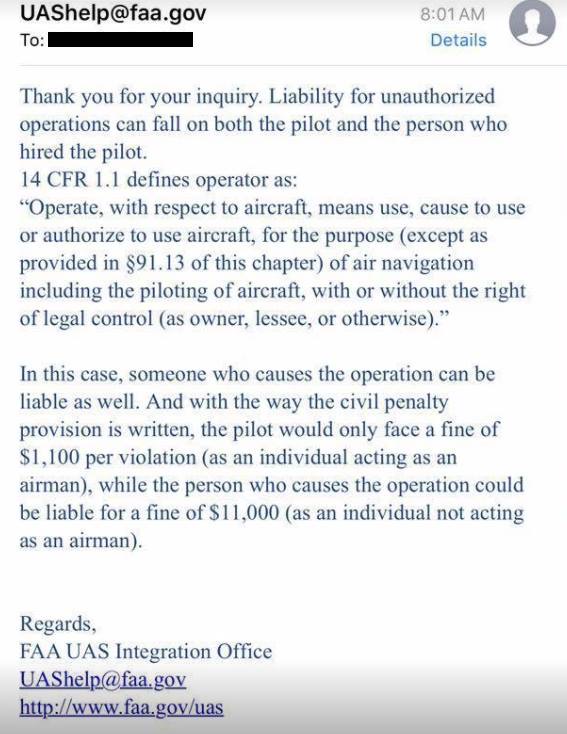An open letter to Realtors and Real Estate Agents (& agency owners).
Drones are great. They’re cool. They’re fun. And they’re an incredible marketing tool.
They’re also relatively easily to fly, readily available at multiple retail and online outlets, and they’re getting relatively inexpensive. If you have as little as $600 and a nearby Best Buy, you can literally been the air in less than an hour with a very capable little drone that is great for most Real Estate work.
And therein lies the problem.
Drones are aircraft. They’re not just toys that can also be used for business. And since they’re aircraft, they come with a set of rules. And those rules are very specific about who can do what with their drone, and where they can do it.
And the insurance industry is watching the drone (UAS) industry very closely. More on why this is important later.
When it comes to improper (& illegal) use of UAS, the realty profession is by far the greatest violator. And no, that’s not a knock on the industry, it’s just evident by the number of complaints. We see many more violations in the real estate industry than any other industry that uses drones. Hobbyists have more violations, but that’s also due to sheer numbers of new hobbyists.
The reasons are varied. First, it’s very likely that the real estate industry is the leading end user of this technology. From single family homes in urban environments, to full commercial listing worth millions of dollars, drone photos and videos are quickly becoming mandatory for marketing. The number of flights for real estate listings is enormous.
Another reason for the violation numbers is education. Or more specifically, lack thereof. So it’s really not the real estate industry’s fault here. We know for a fact the FAA is trying its best to get the word out. But getting that word out is a multi-faceted problem. And not one easily remedied. Even the National Association of Realtors (NAR) has attempted to get into the education field. In June they posted this video on their YouTube account. Sadly, as of this writing, it’s only had 550 views. With over 20,000 YT subscribers on the NAR channel, that should be a much higher number. It’s a good video, albeit with a few wrong dates.
And finally, the third most likely reason is what the FAA calls “hazardous attitudes of aeronautical decision making”. The FAA even trains both manned and unmanned pilots about these very issues. There are actually 5 separate attitudes, but for the purpose of brevity, we’ll just talk about two of them, anti-authority and invulnerability. We’ll start with hazardous attitudes and get those out of the way. It’s not really the crux of this article.
In the drone industry, we hear about both of these attitudes when we talk to those who aren’t following the rules. Anti-authority folks take the attitude of “rules don’t apply to me. The FAA can’t stop me”. Those folks are wrong in both instances. Aviation rules are there for safety, and they apply to anyone who puts a drone in the air. Ignoring them out of a false sense of superiority is a quick way to find out just how wrong you are.
But invulnerability is the one that most often jumps up and bites someone in the backside when it come to drone crashes. “It can’t happen to me”, or “I know that I’m doing” are seemingly the precursors to instances of pilot error. And pilot error is the leading cause of UAS incidents. By far.
We aren’t going to address the remedies for hazardous attitudes, there is plenty of info on the webs if you feel like diving deeper here. But pointing them out is critical to airspace safety.
And of course, sheer numbers of real estate drone flights may be one of the leading causes of violations, but it’s not really an addressable issue. It’s just a fact. So we won’t spend time on that either. Other than to say we love to see the Real Estate industry’s massive acceptance of commercial drone use. They really were the early adopters, and have helped pave the way for public acceptance as well.
So this is NOT an anti-real estate article, this is an educational one.
So let’s educate.
14 CFR Part 107 (a.k.a 107 or Remote Pilot Certificate) are the default rules for all drone flown in the United States that are under 55 pounds. Regardless of who is flying them. There are of course exceptions to those rules, with law enforcement, educational institutions, and hobby (recreational) use being the three most common. We’ll only talk about the recreational exception in this article.
And contrary to popular opinion, there is no grey area when it comes to how those rules are applied. You are either flying under Part 107, or you’re not. And when it comes to the real estate industry you are always flying under 107 rules. Period.
A complete course about drone use under 107 takes hours, if not days. And then there is the hours of follow-up studying to do before you take the test to become a 107 Drone Pilot. We’re obviously not going do that here, but if you are interested in obtaining your 107 (or realize you need it after reading this article), we strongly recommend the Pilot Institute. Unlike many other online courses, PI doesn’t just teach to pass the 107 test. They want you to succeed as a business and fly safe once you do pass the test. In our opinion, they truly are the best online experience when it comes to studying for your Remote Pilot Certificate.
So what is the summary of 107 rules so you know how to fly safe? We’ll hit the highlights.
First, you have to register your drone. Since it’s going to be used for commercial use, it has to be registered no matter the weight. Recreational drones under 250 grams don’t need to be registered. And the two most common of those are the DJI Mini as well as the new Autel Nano. Those are marketed as recreational drones that don’t need to be registered. But they do need to be registered if flown under 107 rules. Don’t forget that.
Airspace is another aspect of drone use that many do not understand. The National Airspace System (NAS) is separated into controlled and uncontrolled airspace. You need to know which airspace you’re flying in. If it’s controlled, you need to obtain permission. If you don’t, and the FAA finds out, you can get fined. And since your listings have addresses, finding out if that flight was in controlled airspace takes all of about 10 seconds. The term “self-incriminating” comes to mind. So knowing your airspace is very, very critical to determining if it’s a legal flight. Many people who fly commercially without a 107 are absolutely clueless about airspace regulations and categories. This is the single most violated issue outside of actually illegally flying under w/o a 107.
Airspace regulations are incredibly critical for the safety of manned aviation. There is a reason your initial 107 test and training will be so heavily weighted with information and questions about airspace classification. Also, there are very specific rules about flying over people and people in moving vehicles. That’s very important when it comes to safety. This is also a very good way for you to get in trouble with the FAA.
Ability to actually fly your drone is key to safety as well (the Pilot Institute does a great job here as well). Yes, they’re silly easy to fly. But if you don’t follow instructions, don’t understand home points, or don’t pay attention to battery levels, this “easy to fly” drone quickly becomes a safety liability in the NAS. And unless you know how to take over control of the drone in an emergency, things can go South very quickly. If you don’t believe me, search “drone crash” on YouTube.
Weather conditions and night flights are also two areas of training that are important to know. And both of those are strictly related to safety as well. TFRs also play a HUGE part if UAS safety.
Again, these are just the tip of the iceberg when it comes to commercial drone flights. Getting your 107 can take some time, but it’s critically important when it comes to safe (& legal) use of drones.
Let’s talk a very little bit about the recreational exception to 107. This is where we see the VAST majority of issues when it comes to not having a 107.
We hear this all the time: “I’m not charging for my services”; “It’s just part of my job, so I don’t need a 107”; “I only charge for editing”; or “I only take photos for friends to use in their business”. Every single one of those excuses is a definite violation of 14 CFR Part 107, and carries the distinct possibility of an FAA fine. And those fines range from $1100 per occurrence, up to $32,600 per occurrence in civil penalties. And if the violation warrants criminal charges, those can range up to $250,000 per occurrences, and/or prison time. Obviously unlikely for illegal use for real estate, but the FAA takes this stuff very seriously.

And did you know that someone who knowingly hires a drone pilot who doesn’t have a Remote Pilot Certificate is liable for up to $11,000 per occurrence? If this is something you do, you may want to start factoring that into your commission formula. So using your friend’s son who just happen to have a drone for your photography (& you know they don’t have a 107), can end up costing you quite a bit.
Suppose a drone person flying for you says they don’t need their 107. Or suppose you’ve convinced yourself you don’t (or even worse, one of your agents has convinced you that they don’t need it). To say the FAA frowns on this behavior is an understatement.
Let’s take a look at what the FAA calls “Exception for limited recreational operations of unmanned aircraft”, technically called 49 USC §44809. The most common excuse we hear is “I’m only flying as a hobby, so I just give my imagery away” and don’t need the 107 (see above excuses).
In order to fly under the recreational exception, there are 8 limitations that must be followed in order to NOT fly under 107. The very first one states,”the aircraft is flown strictly for recreational purposes.” Obviously, if someone if giving you the imagery, just charging for editing, or “only doing it as a friend”, they are not flying strictly for recreation and aren’t under the “exception” rules above. That means they MUST have their 107.
We could give examples and instruction ad nauseam, but that’s not the point of this article.
The intent of this article is to be brutally honest. It’s very unlikely the FAA will ever fine you for flying illegally for your listings, or illegally hiring someone who does it for you. And if you’re caught, the first step in likely going to be a letter explaining the actual rules. And that’s likely it, end of story. Of course, you’re now on record as being official told the rules, so that would definitely be a good time to actually start following them. A better time would be to start following them BEFORE you get in trouble with the FAA.
So, unless of course unless there is an accident or incident with the drone, the FAA isn’t likely to find out. However, if there is an incident, it becomes an accident investigation and you’ll likely get much more than a friendly letter.
And remember above, when I mentioned the insurance industry? Well, that’s who you really need to worry about. Because that’s what’s going to bite you in the backside if there is ever an “incident”.
As we all know, the insurance industry is risk averse by nature. Risk is literally the backbone of their industry. Premiums and payouts are based on risk mitigation and likelihood of incident. And they have entire departments tasked with doing nothing but evaluation the legalities and risk mitigations involved in each and every claim filed against a policy owner. It’s their actual job to see if there is an exception found in the policy they could use to reject a payout on a claim. Objectively, they’re trying to prevent fraud. But if they find a legal loophole to deny a claim, they’ll use that attempt too. We have nothing against the insurance industry, that’s just the way that industry works. And when it comes to drone claims, extra scrutiny is going to be applied since it’s still a fairly new industry. And if the drone flight wasn’t following FAA regulations, that would be considered an illegal flight, and the claim will be denied. You can almost bet the firm on that outcome.
And if their insurance claim is denied, you are literally betting the firm on that illegal flight.
Because if there is an incident, and insurance says tough bananas on a payout, guess who the homeowner (and/or any other victims) is going to come after for damages? In this order that would be the drone operator, the agent, and the agent’s brokerage. And guess which one of those three parties has the deepest pockets? So if you’re a brokerage owner, you should be paying extra attention here.
So, is hiring an illegal drone operator (or flying a drone yourself, or not checking up on your agents) worth the risk? What is the likelihood of an incident? Odds are pretty good that if the person providing your drone imagery for your listing isn’t legal, then they’re not trained. And if they’re not trained, they have no idea what safety even means. And they’re most definitely NOT carrying insurance.
What can you do to prevent this happening to you?
Well, if you’re the one flying without a Remote Pilot Certificate, quit. Get your 107. It’s a whole heck of a lot cheaper than a court case (or an FAA fine).
If you’re the one hiring the drone operator, ask to see a copy of their Remote Pilot Certificate. If the date on it is over 2 years old, ask to see the Recurrent paperwork too. And ask to see their insurance certificate. There are also insurance companies that offer per flight policies. If they use those, make sure they have that applied for as well. If they are a legitimate and legal Part 107 Drone Pilot, not only will they be happy to show you their certifications, they’ll likely thank you for helping keep the skies safe.
And finally, if you’re the owner of a brokerage firm, make sure your agents only use legal drone pilots. And if you have your favorite pilots, hand out a list of those preferred pilots to your agents. And if one of your agents is flying illegally, sit them down and have a nice heart-to-heart with them and explain the rules of your brokerage firm.
It could save your agency.
——————————————————————–
Please consider joining Drone Service Providers Alliance and help us help you by keeping the skies free from unnecessary regulations at both the federal and state levels.
Sign up for our newsletter and subscribe to our YouTube Channel.




Good info !
Great article. Very informative.